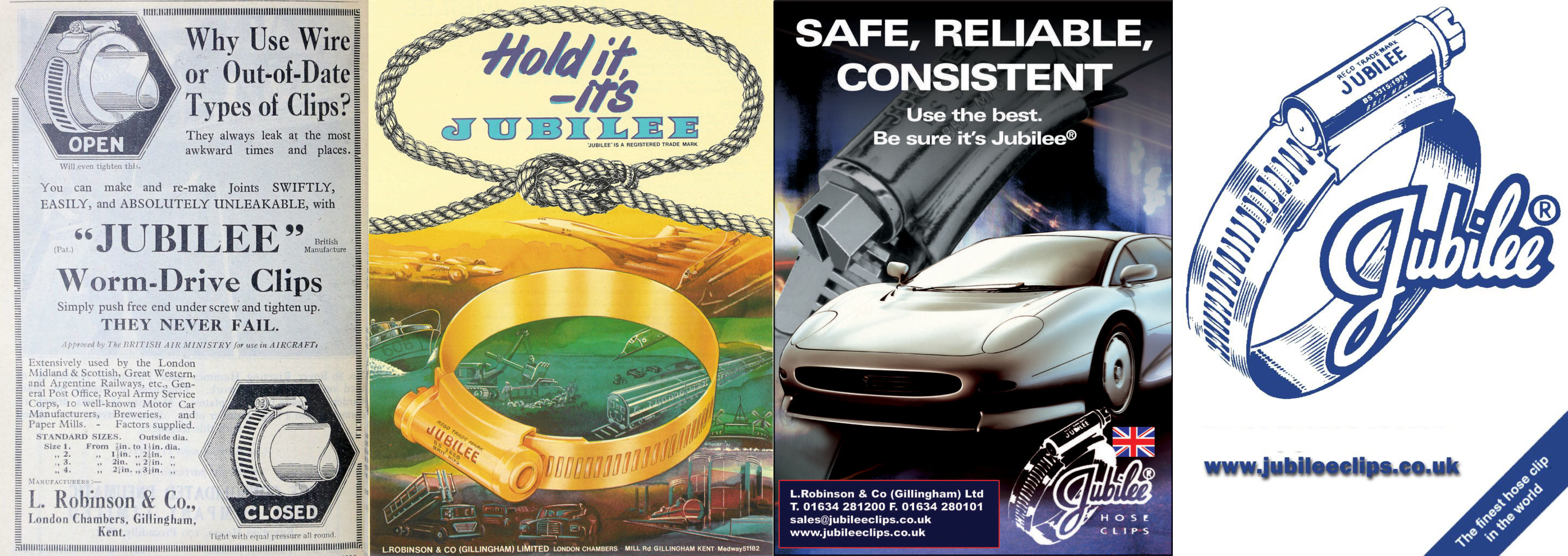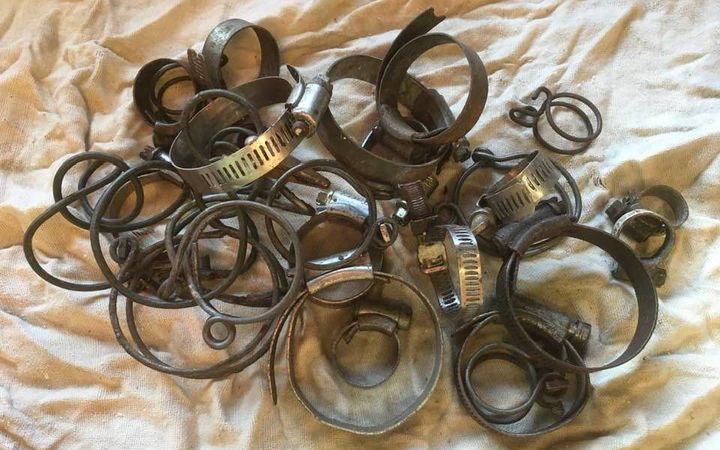Jubilee clips

|
| Jubilee® is a registered trade mark of L Robinson & Co (Gillingham) Limited. |
The Jubilee clip is a brand name that is often used instead of the technical name worm drive hose clamp, which is a type of ring clamp used to join hoses tightly. It has a steel band with teeth and a screw to tighten and loosen the grip of the clip. These are also sometimes called hose clamps, or just hose clips, it is not known why the name Jubilee was used for the original company but various theories exist such as it being the local street name of the inventor.
The Jubilee® worm drive hose clip was invented in April 1921 and patented by Commander Lumley Robinson, the founder of L Robinson and Company. It was during his time in the Royal Navy, which included spending several hours in the sea when his ship sank, during World War I, that he saw the need for a new and better way to attach hoses to pipes.
After leaving the Navy and spending time testing his ideas in a friend's workshop, Commander Lumley invented the first Jubilee clip, which quite quickly became a commercial success. When World War II broke out the Jubilee clip was seen as an important contribution to the war effort. The Commander sadly died just before the war started and the Ministry wanted to take over the firm, in response his widow, decided to run the company herself, which she did, throughout the war, supplying clips to the services.
After the war ended Ms. Lumley-Robinson continued to run the company herself along with her youngest son. The company continued to grow, expanding across Europe and beyond. It continues to be successful and Jubilee clips are a staple piece of equipment for many industries from aeronautics to automobiles and service engineers to plumbers. Today, it is run by the great-grandson of the original inventor, making him the fourth generation of the family to hold the position of managing director.
[edit] External links
For more information about the founders of the original Jubilee clips visit https://www.jubileeclips.co.uk/about-us/history/
[edit] Related articles on Designing Buildings
- Adhesives.
- Clamp.
- Construction equipment.
- Construction tools.
- Cramp.
- Crimp.
- Fixings.
- Fixtures.
- Ground anchor.
- Industrial fasteners market.
- Rivet.
- Soil nailing.
- Staples.
- Strap.
- The history of nails.
- Timber.
- Types of bolts.
- Types of fixings.
- Types of nails.
- Types of nuts.
- Types of screws.
- Types of washer.
- Welding.
Featured articles and news
Latest Build UK Building Safety Regime explainer published
Key elements in one short, now updated document.
UKGBC launch the UK Climate Resilience Roadmap
First guidance of its kind on direct climate impacts for the built environment and how it can adapt.
CLC Health, Safety and Wellbeing Strategy 2025
Launched by the Minister for Industry to look at fatalities on site, improving mental health and other issues.
One of the most impressive Victorian architects. Book review.
Common Assessment Standard now with building safety
New CAS update now includes mandatory building safety questions.
RTPI leader to become new CIOB Chief Executive Officer
Dr Victoria Hills MRTPI, FICE to take over after Caroline Gumble’s departure.
Social and affordable housing, a long term plan for delivery
The “Delivering a Decade of Renewal for Social and Affordable Housing” strategy sets out future path.
A change to adoptive architecture
Effects of global weather warming on architectural detailing, material choice and human interaction.
The proposed publicly owned and backed subsidiary of Homes England, to facilitate new homes.
How big is the problem and what can we do to mitigate the effects?
Overheating guidance and tools for building designers
A number of cool guides to help with the heat.
The UK's Modern Industrial Strategy: A 10 year plan
Previous consultation criticism, current key elements and general support with some persisting reservations.
Building Safety Regulator reforms
New roles, new staff and a new fast track service pave the way for a single construction regulator.
Architectural Technologist CPDs and Communications
CIAT CPD… and how you can do it!
Cooling centres and cool spaces
Managing extreme heat in cities by directing the public to places for heat stress relief and water sources.
Winter gardens: A brief history and warm variations
Extending the season with glass in different forms and terms.
Restoring Great Yarmouth's Winter Gardens
Transforming one of the least sustainable constructions imaginable.























